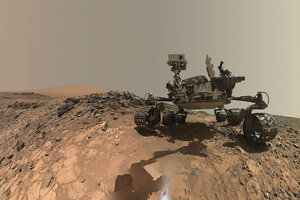Big announcement: Did NASA just find liquid water on Mars?
The US space agency has scheduled a special news conference for 11:30 a.m. ET on Monday to announce a 'major science finding.'

NASA's Curiosity Mars rover is seen in this low-angle self-portrait taken August 5, 2015 and released August 19, 2015. The selfie combines several component images taken by Curiosity's Mars Hand Lens Imager (MAHLI) during the 1,065th Martian day, or sol, of the rover's work on Mars, according to a NASA news release.
NASA/Reuters
NASA will announce a "major science finding" about Mars on Monday.
A news conference is scheduled for 11:30 a.m. ET, and will be broadcast live on NASA Television as well as its website.
The space agency’s press release does not specify what the finding is, but the list of participants in the news conference provides some clues.
One of the names is Lujendra Ojha, a Ph.D. candidate in planetary science who co-authored a study published in Science in 2011 claiming the first evidence of what could be liquid briny water on Mars. The source of this water could be below the surface, Mr. Ojha said at the time.
"There's going to be years of research put into this to even prove that this is definitely a proof of water. And from that, we can move on: OK if this is water, what are the chances that life could be in these kinds of surroundings?" he said.
NASA currently has five active missions on Mars. The two rovers Opportunity and Curiosity, which landed in 2004 and 2012, respectively, and three orbiters Mars Odyssey, MRO, and MAVEN (which stands for Mars Environment and Volatile Evolution).
The MRO orbiter, which has been in space since 2006, has the HiRISE camera onboard. The principal investigator for the camera, Alfred McEwen, will be part of Monday’s conference.
The HiRISE camera features a telescopic lens that can pick out features as small as one meter across on the Martian surface. The camera also collects images in near-infrared wavelengths, allowing researchers to learn about the mineralogy of Mars, according to Space.com.
"These new, high-resolution images are providing unprecedented views of layered materials, gullies, channels, and other science targets, in addition to characterizing possible future landing sites," NASA officials wrote in a description of the HiRISE instrument.
Jim Green, director of planetary science at NASA headquarters, will be taking part in Monday's news conference. Michael Meyer, lead scientist for the Mars Exploration Program, and Mary Beth Wilheim, of NASA's Ames Research Center in Moffett Field, will be participating as well.
NASA has plans to send humans to Mars by the 2030s and is currently developing capabilities to make long-term space travel possible.
During Monday's conference, NASA will be answering questions from the public on Twitter using the hashtag #AskNASA.

